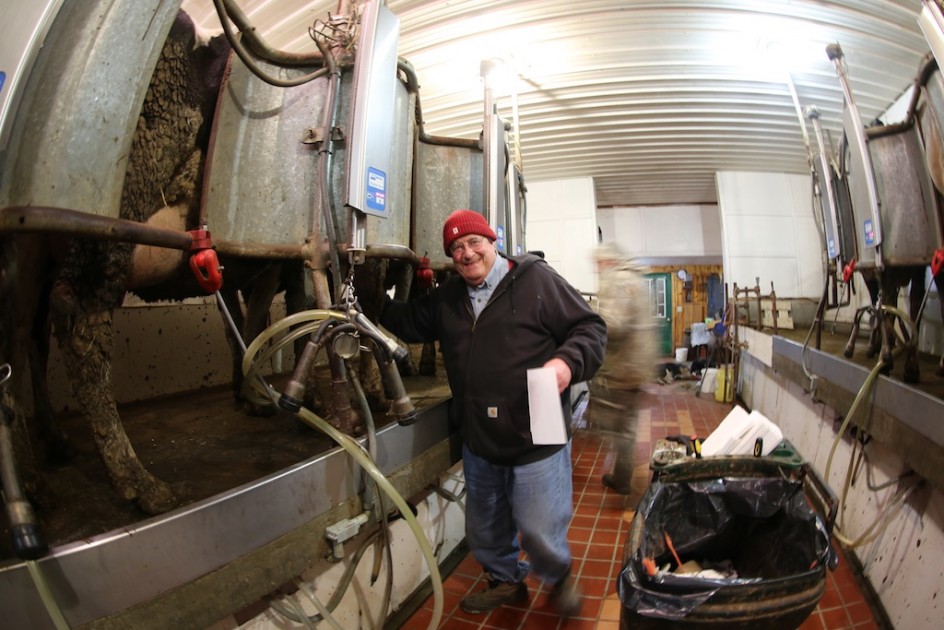
I decided yesterday it was time to learn how to milk a cow. This is not, of course, possible in just a few hours. Milking is far more complex than it might seem and very different from the stereotype many people have of the old farmer sitting on his stool pulling Bessie’s teats.
I am not a farmer, but a writer with a farm. And I was reminded Saturday night that I would not make a good farmer. Writing is for me. The Gulleys fed us pizza before the milking, the second milking of the day. There are two. Every day of the year, milking shapes and bounds the dairy farmer’s life.
There is a medieval quality to almost all of the family farms I have been in – crowded barns, dripping pipes, the very strong smell of manure, barn cats and dogs milling around, purring water pipes and milk transport and storage systems. The milking parlor at Bejosh Farm is one of the best designed I have seen, the cows come in on raised walkways, you have to reach up , not down, to hook them up. Electronic sensor systems flash an alert when the milking is done, and the tubes disengage automatically with the push of a button.
The milk is fed through continuously sanitized plastic tubes to milking tanks in rooms that are spotless. Cows are not spotless, they are big and usually dirty. Often there is mud all over their feet and legs and they drop manure almost continuously. Everyone nearby gets splattered, their clothes (and nostrils) will long retain the smell.
Ed writes about the farmer’s life on his blog.
The Gulleys are milking about 35-40 cows right now. They know each one by name and are intimately familiar with their teats, moods, medical history, and milking habits. They recognize each one by name, and know just when their milk is about finished. Watch out for Daisy, Ed shouted, she kicks. Too late, she had already kicked my arm twice, it was not a big deal.
There are about 25 or 30 steps to talk – how to turn the sensors on, hook up the hoses, place the tubes, disconnected them, re-connect them to the cleaning tubes that will blow scalding hot water through them when the milking is done. The manure has to be raked out by hand of course, the cows guided from the barn to the milking stations and then out again.
Ed and Carol love their cows very much, they talk to them, encourage them, check each one to see how they are. I got to spray an iodine mix on the teats to clean them up, then attached the milking tubes – four for each cow, and then disconnect them and get them ready for cleaning. I learned about one-tenth of what you need to know to milk a cow confidently.
The cows are surprising. They are agreeable, curious about strangers, they walk in slowly and leave slowly, almost in slow motion. Nobody gets excited. I am told by farmers that this is the sign of a well-cared for cow, they are trusting and patient. It is sometimes different, I’ve seen milking barns that are more chaotic than this, Ed and Carol Gulley have been doing this for decades, they know their stuff.
Their Aussie shepherds mill about, barking and joining in, then lying down to watch.
Maria is offering a bonus video of the quite startling process of artificially inseminating a cow. Ed showsed us his breeding can, where he stores his semen and collects it in a long syringe. He put on a plastic sleeve and reached into the cow’s rear, cleaned out the manure, felt around for the right spot and injected the semen into the uterus. Definitely worth a look.
I want to do it again, there is a spirit of family, history and the natural world that lives on farms, it is pleasure to be even a small part of it. On his blog, Ed describes encountering a small hawk in his chicken coop. There is rarely a 911 call made from a small farm. You need to figure it out yourself. Ed says he enjoyed having pizza with us Saturday night, he even put his teeth in at Carol’s insistence.
